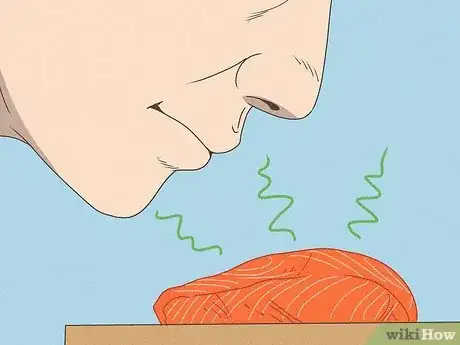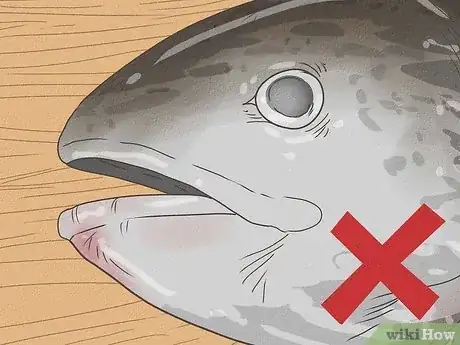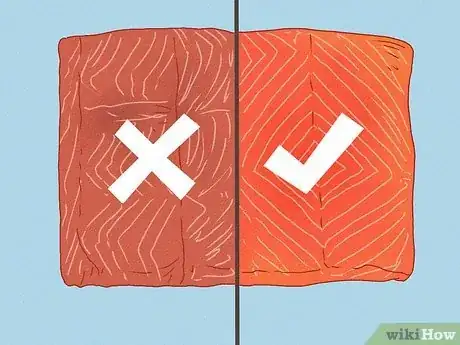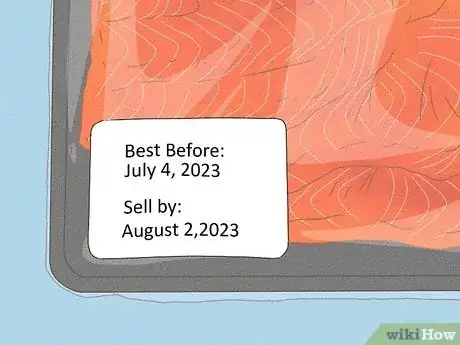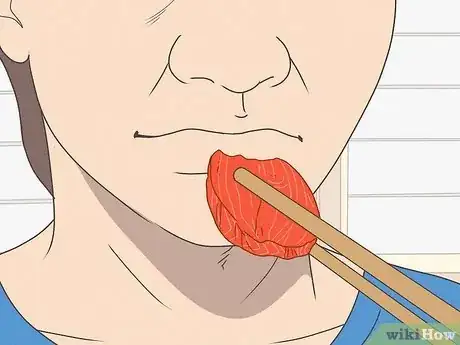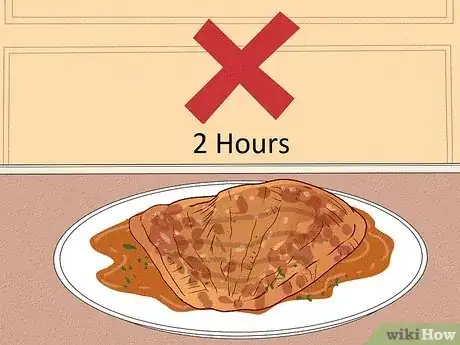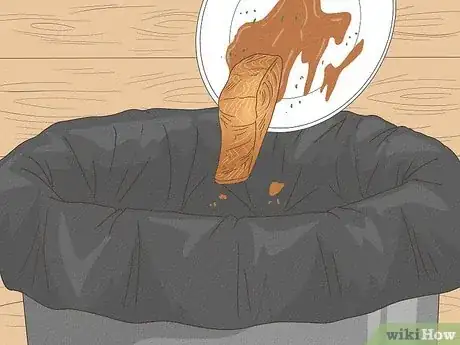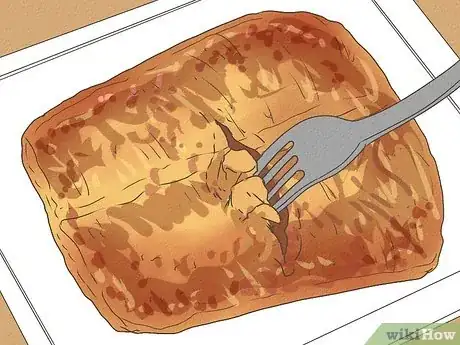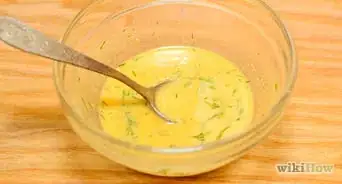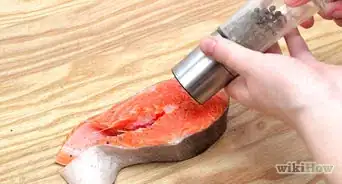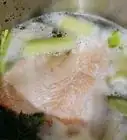This article was co-authored by Abyssinia Campbell and by wikiHow staff writer, Hunter Rising. Abyssinia Campbell is an Executive Chef and the Owner of Chef Abyssinia, Personal Chef and Catering. With over ten years of experience, she specializes in catering, event planning, menu development, meal planning, and food business operations. When it comes to cooking, Chef Abyssinia enjoys using fruits, vegetables, healthy food alternatives, and local farm-fresh ingredients. She holds a BASc in Culinary Arts and Food Service Management from Johnson and Wales University.
There are 13 references cited in this article, which can be found at the bottom of the page.
This article has been viewed 563,478 times.
Do you want to enjoy a delicious piece of salmon, but you're worried it might be spoiled? Whether you’re cooking a fresh filet or reheating some leftovers, it’s important to make sure your salmon is still good so you don’t get sick. Luckily, it’s really easy to check your salmon and notice the signs of spoilage. Keep reading to find out when your salmon is still okay to eat and when it’s best to toss it out.
Things You Should Know
- Raw salmon has spoiled if it has a strong ammonia odor, white film on the meat, dull coloration, and mushy consistency.
- Leftover cooked salmon spoils after 2–3 days, or when it has a sour odor and slimy texture.
- Use salmon within 1–2 days of the “sell by” date on the packaging, or before the “best by” date.
Steps
Raw
-
1
-
2Look for a milky coating on the fish. Before cooking, inspect your salmon to make sure it doesn't have a translucent white film on its surface.[3] If you see any type of slimy film developing on your salmon, toss it out.[4]Advertisement
-
3Poke the salmon to see if it breaks apart easily. Press your finger into the meat to check the raw salmon’s consistency. If the fish holds together and springs back to its original shape, then it’s okay to cook the meat. However, if the meat easily mushes or breaks apart when you handle it, throw it away.[5]
-
4Inspect the salmon’s eyes for cloudy discoloration. If you purchase salmon with the head still on, check the appearance of its eyes. Fresh salmon should have bright, clear eyes with a dark pupil in the middle. When the fish goes bad, the eyes appear discolored.[6]
- The eyes on fresh salmon also appear to slightly bulge. If the eyes are sunken in, the fish has likely gone bad.
-
5Check if the meat has a dull, pale color. Fresh salmon should have a bright pink or orange color when it’s still good to eat. If your salmon has a pale gray or pink color, then it’s probably best to throw it away.[7]
- Fresh salmon also has fine white lines running through it, which indicate freshness. If you don’t see any white lines, your salmon has spoiled.
-
6Look at the "best before" and "sell by" dates. If you are in doubt about the quality of your salmon, check the "best before" date indicated on the packaging. This date is not a definite prediction of when your fish will go bad, but it gives you a good idea of when it might spoil. Then, look at the "sell by" date on the packaging to see how much time has passed.[8]
- As a general rule, refrigerated fresh salmon will keep for 1–2 days after its "sell by" date.[9]
Cooked
-
1Check for a foul, sour odor. Give your salmon a sniff test to see if it has a foul fishy or rotten odor. If the salmon is still good, then it will have a mild, appetizing smell instead.[10]
-
2Feel if the salmon has a slimy texture. Touch the leftover cooked salmon to see if it has a slimy consistency. If your salmon has lost its thick, flaky texture, then it’s starting to go bad and could make you sick. Throw it away if it has any sliminess to it.[11]
-
3Avoid leaving cooked salmon at room temperature for over 2 hours. If cooked salmon sits out at room temperature, bacteria will begin to grow on the meat. Always take note of the time you cook salmon or the time that you order it at a restaurant, and the time you are able to put it into the fridge to make sure it’s still safe to eat.[12]
-
4Throw away leftovers that are more than 2–3 days old. Regardless of whether the salmon appears to be spoiled, toss it out after 3 days. Since bacteria and mold start growing after a few days, eating the leftover salmon past that range could make your really sick.[13]
Cooking Salmon Safely
-
1Use your fork to see if the fish flakes. Gently scrape through the salmon steak or fillet with your fork to see how the meat reacts. When you cook salmon properly, it will easily break into flakes when nudged. If your fish feels dense or rubbery, then it isn't cooked properly.[14]
-
2Look for opaque meat. Cut into your piece of salmon at its thickest point and inspect its color. Fully cooked fish will have a solid opaque color. If the salmon appears translucent, let it cook for longer.[15]
-
3Check that the fish is at least 145 °F (63 °C) in the middle. Stick a meat thermometer into the thickest part of the meat and let it sit for a minute to get an accurate reading. As long as the internal temperature is at or above 145 °F (63 °C), your salmon is cooked all the way through.[16]
- If you eat salmon before it reaches the proper temperature, it could make you sick.
Community Q&A
-
QuestionIf the salmon is a greyish colour only on the bottom but the rest is totally fine, is it still off?
 wikiHow Staff EditorThis answer was written by one of our trained team of researchers who validated it for accuracy and comprehensiveness.
wikiHow Staff EditorThis answer was written by one of our trained team of researchers who validated it for accuracy and comprehensiveness.
Staff Answer wikiHow Staff EditorStaff AnswerIt's normal for the meat right next to the skin to have a grayish color. Just make sure that the rest of the meat isn't discolored or slimy.
wikiHow Staff EditorStaff AnswerIt's normal for the meat right next to the skin to have a grayish color. Just make sure that the rest of the meat isn't discolored or slimy. -
QuestionHow do I cook already smoked salmon?Smoked salmon does not require more cooking - the smoking process has already cooked the fish. Enjoy warm or cold!
-
QuestionHow do I know if canned salmon is bad?
 Community AnswerAlthough it may seem counter intuitive because salmon is a type of fish, if it's still edible it should not smell unpleasantly "fishy" in any way. If your salmon smells somewhat sour or anything like ammonia,, it has gone bad and you need to toss it. Fresh salmon has a mild aroma, or one that smells similar to the sea.
Community AnswerAlthough it may seem counter intuitive because salmon is a type of fish, if it's still edible it should not smell unpleasantly "fishy" in any way. If your salmon smells somewhat sour or anything like ammonia,, it has gone bad and you need to toss it. Fresh salmon has a mild aroma, or one that smells similar to the sea.
Warnings
- Eating salmon that’s gone bad can cause food poisoning. If you have diarrhea, stomach pain, nausea, vomiting, or a fever, then you could have food poisoning. See a doctor if you notice blood in your stool, diarrhea lasting more than 3 days, or difficulty keeping liquids down.[19]⧼thumbs_response⧽
References
- ↑ Abyssinia Campbell. Executive Chef. Expert Interview. 31 August 2021.
- ↑ https://www.fda.gov/food/resourcesforyou/consumers/ucm077331.htm
- ↑ Abyssinia Campbell. Executive Chef. Expert Interview. 31 August 2021.
- ↑ https://cfaes.osu.edu/news/articles/chow-line-tapeworms-in-salmon-potential-risk
- ↑ https://www.fda.gov/food/buy-store-serve-safe-food/selecting-and-serving-fresh-and-frozen-seafood-safely
- ↑ Abyssinia Campbell. Executive Chef. Expert Interview. 31 August 2021.
- ↑ https://cfaes.osu.edu/news/articles/chow-line-tapeworms-in-salmon-potential-risk
- ↑ https://www.fsis.usda.gov/food-safety/safe-food-handling-and-preparation/food-safety-basics/food-product-dating
- ↑ https://www.fda.gov/media/101389/download
- ↑ http://www.stilltasty.com/fooditems/index/18244
- ↑ Abyssinia Campbell. Executive Chef. Expert Interview. 31 August 2021.
- ↑ http://www.stilltasty.com/fooditems/index/18244
- ↑ https://www.fsis.usda.gov/food-safety/safe-food-handling-and-preparation/food-safety-basics/leftovers-and-food-safety
- ↑ https://www.bonappetit.com/story/how-to-tell-if-salmon-is-cooked
- ↑ https://www.southernliving.com/food/seafood/fish/salmon/how-to-tell-when-salmon-is-done
- ↑ https://www.fsis.usda.gov/food-safety/safe-food-handling-and-preparation/food-safety-basics/safe-temperature-chart
- ↑ https://doh.wa.gov/community-and-environment/food/fish/farmed-salmon
- ↑ https://www.fda.gov/media/101389/download
- ↑ https://www.cdc.gov/foodsafety/symptoms.html
About This Article
To know if fresh salmon is bad, check the smell. Fresh salmon has a mild scent, so if yours smells pungent or ammonia-like, it's probably bad. You can also inspect the surface for a white, translucent skin. If you see a milky film on your salmon, get rid of it. You'll know cooked salmon is bad if it has a foul odor and slimy texture. If leftover salmon sat out at room temperature for 2 or more hours, toss it. Leftover salmon that's been in your fridge longer than 3 days should also be thrown out. If you want to learn how to check if salmon is cooked properly, keep reading!
